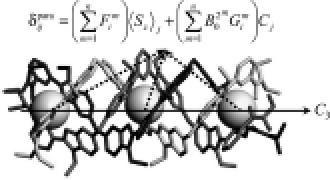-
The solution structure of homotrimetallic lanthanide helicates investigated with novel model-free multi-centre paramagnetic NMR methods
N. Ouali, J.-P. Rivera, , J. Weber and C. Piguet
Dalton Transactions, (7) (2003), p1251-1263


DOI:10.1039/b212352e | unige:3505 | Abstract | Article HTML | Article PDF

The combination of one contact and three pseudo-contact contributions to the NMR hyperfine paramagnetic shift of each proton in the triple-stranded helicates [Ln3(L1)3]9+(Ln = Ce–Yb except Pm, Gd) produce intractable 1H NMR spectra whose assignment is limited by the large electronic contribution to the nuclear relaxation processes. The detailed analysis of the NMR spectra for the diamagnetic complexes [Ln3(L1)3]9+(Ln = La, Lu, Y) shows that the triple-helical structure found in the solid state is maintained in solution. Extension of the classical one-nucleus crystal-field dependent model-free method for paramagnetic D3-symmetrical homotrimetallic lanthanide complexes possessing two different metallic sites (i.e. two second-rank crystal-field parameters: B20central and B20terminal) allows (i) the complete interpretation of the paramagnetic signals for Ln = Ce–Yb and (ii) the detection of a concomitant abrupt change of the contact terms Fi and of the pseudo-contact terms Si=B20centralG1i+B20terminal(G2i+G3i) occurring near the middle of the lanthanide series. The derivation and application of a novel three-nuclei crystal-field independent method eventually demonstrates that the helicates [Ln3(L1)3]9+ adopt a single D3-symmetrical structure along the complete lanthanide series in solution, which ascribes the discontinuity observed for Si to a concomitant decrease of the two crystal-field parameters. Comparison with structural models is limited by the extreme sensitivity of the structural factors Cikl and Dikl to minor geometrical variations affecting the wrapping of the ligand strands, but calculations of the geometrical factors Gmi(m= 1–3) for [Ln3(L1)3]9+ in solution confirm the formation of a regular triple-helical structure. Generalization of this novel three-nuclei method for addressing the solution structure of rhombic lanthanide complexes is discussed.